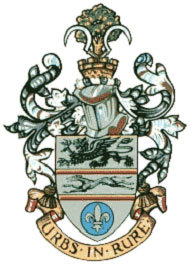Council services over Christmas
Some of our services will change during the festive season.
The history of the borough of Solihull
 The present Metropolitan Borough of Solihull has existed since 1st April 1974 when the Local Government Act 1972 came into force and created the Solihull Metropolitan Borough Council.
The present Metropolitan Borough of Solihull has existed since 1st April 1974 when the Local Government Act 1972 came into force and created the Solihull Metropolitan Borough Council.
This new Metropolitan Borough was formed by merging the old County Borough of Solihull with parts of Stratford and Meriden Rural District Councils.
A list of past and present Mayors of Solihull is available.
For information on the history of areas within the Solihull Metropolitan Borough, see our local areas history pages.
The new borough incorporated the civil parishes of Balsall, Barston, Berkswell, Castle Bromwich, Chelmsley Wood, Fordbridge, Hampton-in-Arden, Hockley Heath, Kingshurst and Meriden, covering a total area of 44,495 acres with a population of almost 200,000.
For information on the Solihull Coat of Arms see our Coat of Arms page.
Minutes of the Solihull Metropolitan Borough Council 1974 to date are available to look at in Solihull Heritage & Local Studies Service
The parish was the basic unit of administration prior to the Poor Law Amendment Act 1834, which allowed parishes to join together and build a workhouse. These Poor Law Unions also formed the initial Registration Districts when the civil registration of births, marriages and deaths was introduced on 1st July 1837.
The Solihull Poor Law Union was formed on 3rd June 1836 and comprised Baddesley Clinton, Balsall, Barston, Elmdon, Knowle, Lapworth, Nuthurst, Packwood, Solihull and Tanworth. The hamlet of Bushwood was added to the Solihull Poor Law Union on 27th February 1857.
In 1872, the Solihull Union Rural Sanitary Authority was created. Rural Sanitary Authorities (RSAs) were created in order to improve public health in rural areas. The Solihull RSA covered 47,427 acres and comprised 12 parishes: Baddesley Clinton; Balsall; Barston; Bushwood; Elmdon; Knowle; Lapworth; Nuthurst; Packwood; Solihull; Tanworth and Yardley (Worcs).
Minutes of the Solihull Union Rural Sanitary Authority 1872-1894 are available to look at in Solihull Heritage & Local Studies Service.
Under the Local Government Act of 1894, the Solihull Rural District Council (RDC) was created, covering an area of 41,807 acres (the parish of Yardley was removed).
Minutes of the Solihull Rural District Council 1894-1932 are available to look at in Solihull Heritage & Local Studies Service.
In 1932, the rural district became an Urban District Council (UDC) as a result of the Warwickshire Review Order of 1932. The rural parishes of Bushwood, Lapworth, Baddesley Clinton, Barston and Balsall, and part of Tanworth-in-Arden (excluding the parish of Salter Street) were transferred to other councils. The urban district covered 20,365 acres.
Minutes of the Solihull Urban District Council 1932-1954 are available to look at in Solihull Heritage & Local Studies Service
On 4th March 1954, Solihull was granted Royal Charter of Incorporation as a Municipal Borough, retaining the same boundaries as the UDC. The charter was presented by H.R.H. The Princess Margaret on 11th March 1954 – Solihull's Charter Day, which saw huge celebrations in the town. The Borough of Solihull officially came into existence at 12 noon on 24th May 1954 and Alderman Robert Douglas Cooper was elected as Solihull's first Mayor.
Minutes of the Solihull Borough Council 1954-1964 are available to look at in Solihull Heritage & Local Studies Service
Ten years later, on 1st April 1964, Solihull (together with Luton) became the first authority to obtain county borough status since Doncaster had attained it in 1927. The Solihull Order 1963, which created the county borough, also ordered that the Parish of Salter Street and the areas of Solihull covering Tidbury Green and Dickens Heath, become the Civil Parish of Hockley Heath which was transferred to the Stratford-upon-Avon Rural District Council. The new county borough of Solihull covered 13,645 acres.
Minutes of the Solihull County Borough Council 1964-1974 are available to look at in Solihull Heritage & Local Studies Service